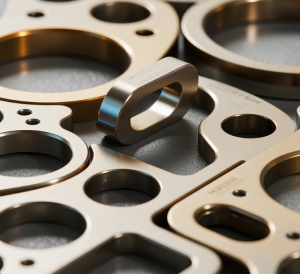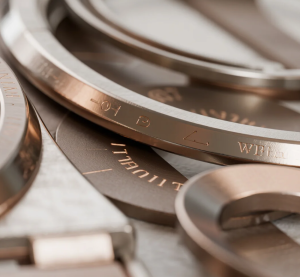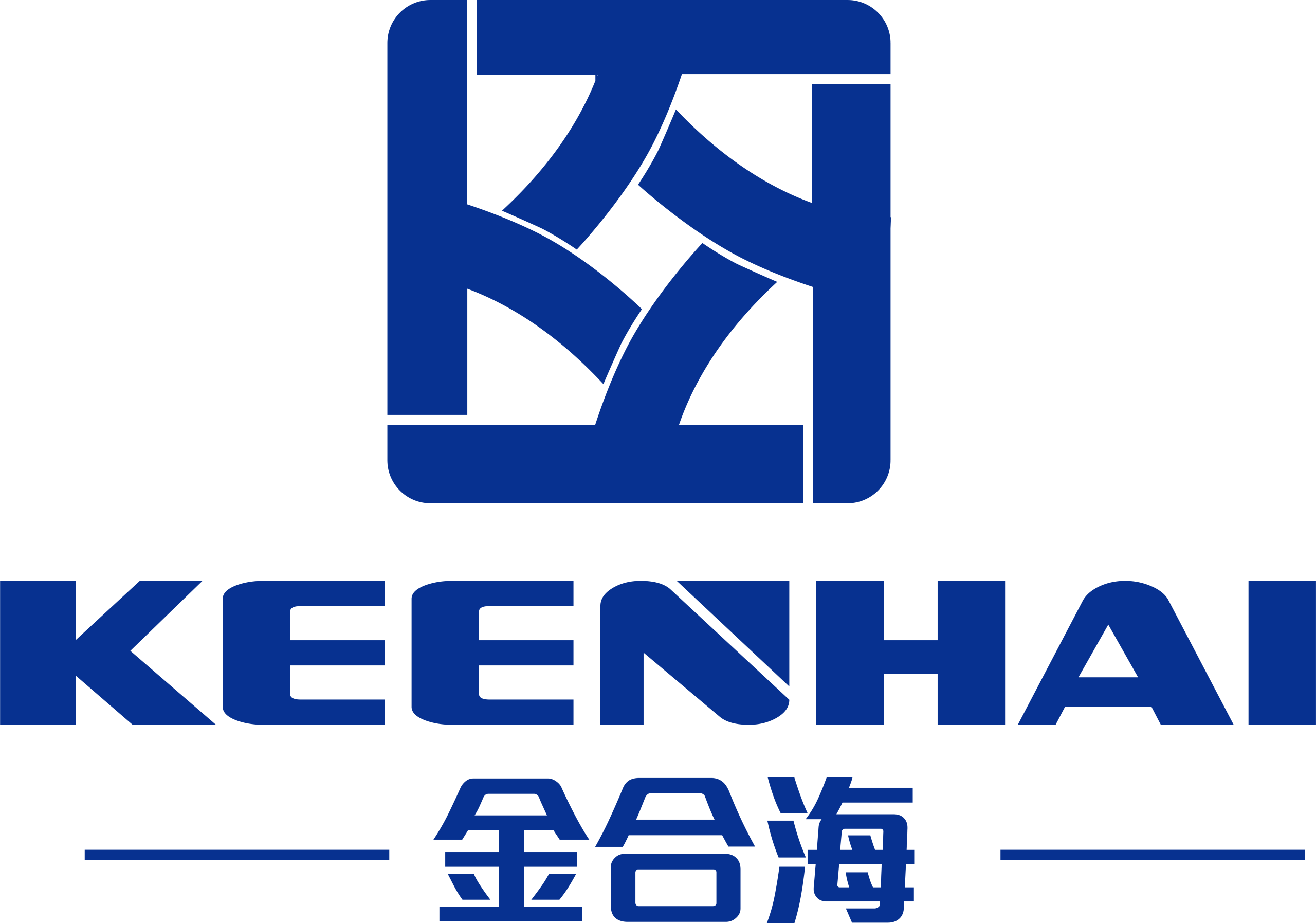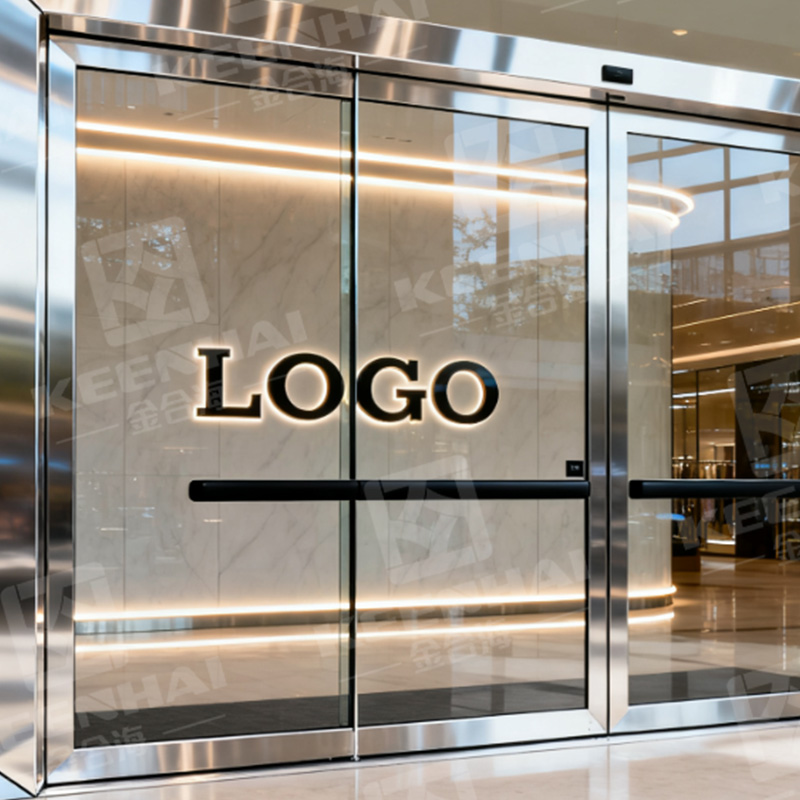PVD coating stainless steel delivers 6-10× scratch resistance and superior corrosion protection.PVD coating stainless steel delivers 6-10× scratch resistance and superior corrosion protection.
The Science Behind PVD Coating
PVD Coating Process Overview
The Physical Vapor Deposition (PVD) process is an advanced method used to enhance stainless steel, offering significant improvements in durability, corrosion resistance, and aesthetic appeal. It starts by evaporating a solid material inside a vacuum chamber, then condensing the vapor onto the stainless steel substrate, forming a durable, hard, and tightly bonded surface layer.
The key factor in the success of the PVD coating process is the controlled environment inside the vacuum chamber. The process takes place under low pressure, usually between 10^-3 to 10^-5 torr, which allows for the vaporized material to travel and settle uniformly on the stainless steel surface. The high level of precision in this environment ensures that PVD coatings are tightly bonded to the surface at an atomic level, providing superior resistance against wear, corrosion, and scratches.
Here’s a breakdown of the main steps involved in PVD coating stainless steel:
-
Vacuum Chamber Setup: The stainless steel is placed inside a vacuum chamber where the air pressure is reduced to ensure that the vaporized material can travel freely and uniformly. This vacuum environment is crucial for achieving the best coating results.
-
Material Evaporation: A target material (such as titanium or zirconium) is heated to high temperatures, often exceeding 2000°C, causing it to vaporize. This material is then directed onto the stainless steel surface.
-
Coating Deposition: The vaporized particles settle on the stainless steel substrate, where they bond at an atomic level, forming a thin but highly durable coating.
-
Cooling and Solidification: After the deposition process, the chamber is gradually cooled. This cooling process solidifies the coating, ensuring it is firmly bonded to the stainless steel.
The quality of the coating is significantly impacted by the purity of the materials used and the precise control over temperature, pressure, and deposition time. A high-quality PVD coating will not only improve the surface properties but also enhance the overall lifespan of the stainless steel, making it ideal for demanding applications.
Advantages of PVD Coating on Stainless Steel
The PVD coating provides stainless steel with exceptional characteristics that traditional coatings simply cannot match. Here’s a comparison of key properties between PVD coating and other common coating methods:
| Property | PVD-tegaĵo | Galvanizado | Powder Coating |
|---|---|---|---|
| Hardness | 2000-3000 HV | 300-500 HV | 400-800 HV |
| Corrosion Resistance | Excellent | Moderate | Good |
| Temperature Resistance | Up to 500°C | Up to 150°C | Up to 250°C |
| Adhesion Strength | Tre Alta | Moderate | Good |
| Fortikeco | Tre Alta | Moderate | Alta |
| Cost | $2-$6 per m² | $1-$3 per m² | $0.5-$2 per m² |
PVD coatings significantly outperform traditional methods in hardness, temperature resistance, kaj corrosion protection. With a hardness of 2000-3000 HV, PVD coatings create surfaces that are extremely resistant to scratches and wear, making them ideal for applications that require long-term durability.
PVD coating for stainless steel significantly improves corrosion resistance and scratch protection. This process is perfect for elevator door panels, architectural stainless steel, and other high-traffic applications.
La koroda rezisto of PVD-coated stainless steel is also outstanding, as it protects against harsh environments, including exposure to salts, acids, and extreme weather conditions. PVD-kovrita rustorezista ŝtalo components are particularly beneficial in industries such as aerospace, automotive, kaj medical devices, where both durability and appearance are crucial.
Key Benefits of PVD Coating
-
Enhanced Wear Resistance: PVD coatings can dramatically improve wear resistance, making stainless steel more capable of withstanding constant friction and abrasion. This feature is particularly important in high-wear applications, such as machinery parts or tools.
-
Improved Aesthetic Appeal: Unlike traditional coatings, PVD can add a range of colors and finishes to stainless steel, such as gold, bronze, or even black. This makes PVD-kovrita rustorezista ŝtalo popular in industries like luxury goods, jewelry, kaj architectural design.
-
Superior Environmental Resistance: The coating also significantly improves the material’s resistance to environmental factors, including heat, humidity, kaj UV radiation, which ensures that the material’s quality and aesthetic appearance remain intact even after prolonged exposure to challenging conditions.
-
Longer Lifespan and Cost Efficiency: PVD coatings extend the lifespan of stainless steel components by protecting them from wear and corrosion, ultimately reducing replacement costs. Studies show that PVD-coated products last up to 10 times longer than untreated stainless steel products, reducing the overall cost of ownership.
Why Choose Us for PVD Coating Stainless Steel?
At PVD Stainless Steel, we offer state-of-the-art PVD coating services that enhance the durability, aesthetic, and performance of your stainless steel products. Here are a few reasons why you should trust us with your PVD coating needs:
-
Profesia Fabrikado: With 15 machines in operation and a capacity of 14,000 square meters per day, we ensure your orders are completed on time and with precision.
-
Flexible Minimum Order Quantities: If we have the specification you need in stock, we can fulfill any order quantity—large or small.
-
Strikta Kvalita Kontrolo: Our coatings are in compliance with ISO 9001:2008, and we utilize the best materials, including PPG kaj KYNAR500 coatings.
-
Reliable Shipping Partners: We offer competitive shipping rates through our trusted partners, ensuring your products reach you promptly and safely.
-
OEM Services: We offer a wide range of decorative patterns and can process according to your specific designs. Let us know your requirements and we’ll make it happen.
By choosing PVD Stainless Steel for your PVD coating needs, you are investing in products that offer superior performance, durability, and aesthetic appeal, ensuring long-lasting satisfaction.

Types of PVD Coating and Their Durability
Physical Vapor Deposition (PVD) Variants
Physical Vapor Deposition (PVD) is a versatile coating process used to improve the properties of materials like stainless steel. It involves vaporizing a solid material in a vacuum and allowing it to condense onto the target substrate. The main types of PVD coatings include Cathodic Arc Deposition (CAD), Magnetron Sputtering, Evaporation Deposition, kaj Ion Plating, each offering distinct advantages in terms of durability, appearance, and application.
-
Cathodic Arc Deposition (CAD): This is one of the most widely used PVD processes. During CAD, a high voltage is applied to a metal target, causing it to ionize and form a vapor, which is then deposited onto the stainless steel surface. This process produces coatings that are extremely hard kaj highly resistant to wear and corrosion. Typically, CAD coatings are used in high-stress applications, such as cutting tools or aerospace components. Hardness values for CAD coatings can range between 2200 to 3000 HV (Vickers hardness), making them suitable for extreme environments.
-
Magnetron Sputtering: This process involves applying a magnetic field to accelerate ions towards a target, causing the target material to sputter and form a vapor that deposits on the surface. Magnetron sputtering is known for its uniform coating kaj excellent control over thickness. Coatings produced by this method have moderate hardness, typically around 1000 to 2000 HV. These coatings are well-suited for decorative applications kaj electronic components, as they provide an attractive finish along with solid durability.
-
Evaporation Deposition: This method involves heating a solid metal source until it evaporates, and then allowing the vapor to condense on the substrate. The key benefit of evaporation deposition is its ability to coat large areas uniformly, making it suitable for thin coatings. The hardness of these coatings is generally lower than other methods, typically ranging from 500 to 1000 HV. This makes it less ideal for high-wear applications but useful for protective layers in electronics kaj optical coatings.
-
Ion Plating: Ion plating uses an ionized vapor to deposit a thin, hard layer onto the target material. The coating produced by ion plating is characterized by its high adhesion strength kaj superior resistance to corrosion. Ion plating is often used in aerospace kaj automotive applications due to its high hardness (typically 2000 to 2500 HV) and thermal resistance. It can also produce coatings in various colors, making it popular for decorative finishes.
How Different Types Impact Durability
The durability of PVD coatings can vary significantly depending on the type of PVD process and the materialo used. Each variant affects the adhesion strength, wear resistance, kaj koroda rezisto of the final product, which ultimately impacts how long the coating will last in real-world applications.
-
Cathodic Arc Deposition (CAD): CAD coatings are among the most durable and hard-wearing. Due to the high-energy environment in CAD, the resulting coatings are extremely resistant to scratches, wear, kaj abrasion, making them perfect for high-performance environments like cutting tools, medical implants, kaj aerospace parts. The coatings typically last up to 10 times longer than untreated stainless steel in abrasive conditions, as they form a dense, non-porous layer. This high hardness helps prevent the degradation of stainless steel surfaces in environments where other coatings may fail prematurely.
-
Magnetron Sputtering: Coatings produced by magnetron sputtering offer good durability for general applications but are not as hard as CAD coatings. They typically feature moderate hardness (1000-2000 HV) and perform well in light to moderate wear conditions, such as in electronics kaj decorative finishes. Magnetron sputtered coatings provide high-quality finishes with excellent color retention and resistance to corrosion. However, compared to CAD coatings, they have a shorter lifespan in high-stress applications, such as automotive or industrial machinery.
-
Evaporation Deposition: Coatings formed through evaporation deposition offer the lowest hardness of all the PVD variants, ranging from 500 to 1000 HV. These coatings are ideal for thin, protective layers and are widely used in optical coatings kaj electronics. While they do provide a level of corrosion resistance, their durability in wear-heavy environments is limited. Evaporated coatings will likely wear off faster than CAD or sputtered coatings, especially under high-friction or abrasive conditions. However, for applications requiring fine coatings over large areas, such as decorative finishes or reflective surfaces, evaporation deposition remains an excellent choice.
-
Ion Plating: Ion plated coatings offer a unique combination of high hardness and superior adhesion strength, making them ideal for aerospace kaj automotive applications. The coating’s wear resistance kaj koroda rezisto are significantly better than those produced by evaporation deposition and magnetron sputtering. Ion-plated surfaces also have a high thermal resistance, which makes them suitable for extreme temperatures. They can last for several years in high-temperature environments without significant degradation. The fortikeco of ion-plated coatings is especially useful for parts exposed to heat cycling, friction, kaj chemical exposure.
Here is a comparison of the durability factors across the different PVD variants:
| PVD Variant | Malmoleco (HV) | Wear Resistance | Corrosion Resistance | Typical Applications |
|---|---|---|---|---|
| Cathodic Arc Deposition | 2200-3000 HV | Excellent | Excellent | Cutting tools, aerospace, medical implants |
| Magnetron Sputtering | 1000-2000 HV | Good | Good | Electronics, decorative coatings |
| Evaporation Deposition | 500-1000 HV | Moderate | Moderate | Optical coatings, decorative finishes |
| Ion Plating | 2000-2500 HV | Tre Alta | Excellent | Aerospace, automotive, high-stress parts |
In terms of overall durability, Cathodic Arc Deposition (CAD) offers the highest resistance to both wear and corrosion, making it suitable for heavy-duty industrial and mechanical applications. On the other hand, magnetron sputtering kaj ion plating provide good durability but may not perform as well in extreme environments where abrasion kaj high temperatures are prevalent. Evaporation deposition serves best for applications that require thin, uniform coatings, but it should not be relied upon in high-wear situations.
The choice of PVD variant largely depends on the specific needs of the application, including environmental exposure, performance requirements, kaj cost considerations. Each method has its own set of trade-offs in terms of coating hardness, adhesion strength, kaj cost, making it crucial to select the right variant based on the intended use.
The Role of Thickness in Durability
How Coating Thickness Affects Strength
La thickness of a PVD coating plays a crucial role in determining the strength kaj overall durability of the coated stainless steel. The thicker the coating, the more it can withstand environmental stress, wear, and corrosion. However, thicker coatings may not always equate to better performance, as there are limits to the benefits gained from increasing coating thickness.
-
Increased Thickness = Higher Hardness: As the thickness of the coating increases, its hardness generally improves, which makes the surface more resistant to scratching kaj abrasion. For instance, a PVD coating with a thickness of 2-3 microns can have a Vickers hardness (HV) of around 1500-2000. Increasing the coating thickness to 5 microns or more may push the hardness up to 2200-3000 HV, providing a surface that can withstand much harsher wear conditions.
-
Impact on Corrosion Resistance: Thicker coatings also tend to enhance the koroda rezisto of the substrate. This is because a thicker layer acts as a more effective barrier against corrosive elements like water, salts, and acids. For example, a 2-micron coating may offer good resistance, but a 5-micron or 10-micron layer can provide more complete protection, especially in harsh, industrial environments where exposure to chemicals is frequent.
-
Reduced Adhesion at Extreme Thicknesses: While thicker coatings offer more protection, they can also pose a risk in terms of adhesion to the stainless steel substrate. As the coating grows thicker, there’s a higher possibility that the bond between the coating and the substrate will weaken, especially if the deposition process isn’t carefully controlled. Typically, coatings above 10 microns tend to show a slight reduction in adhesion strength, which can lead to premature coating failure if exposed to high mechanical stress.
In summary, PVD coating thickness is directly related to both the hardness kaj resistance of the coated surface. However, there are trade-offs between coating thickness and other factors like adhesion strength kaj cost.
Optimal Thickness for Maximum Durability
La optimal thickness for PVD coatings largely depends on the specific application and environment in which the coated stainless steel will be used. There is a balance between achieving maximum durability and avoiding unnecessary costs or coating failure.
-
General Guidelines for Thickness:
-
Light to Moderate Wear: For applications like decorative finishes, electronics, kaj medical devices, a coating thickness of 1-2 microns is often sufficient. At this thickness, the PVD coating provides a good combination of appearance kaj protection, without excessive cost.
-
Heavy Wear and Corrosive Environments: For components subjected to high wear, abrasive conditions, or harsh chemicals, 3-5 microns is considered optimal. Coatings in this range provide the best balance of fortikeco kaj adhesion, ensuring the material lasts longer without becoming too brittle.
-
Extreme Conditions: For environments with extreme wear, such as cutting tools, aerospace, aŭ high-performance automotive parts, coatings as thick as 10 microns may be necessary. These coatings provide maximum hardness kaj koroda rezisto, but it’s crucial to ensure that the bonding process is controlled to prevent delamination.
-
-
Effect on Performance: Thickness directly impacts the performance characteristics of the coating. A thicker coating will generally increase the wear resistance kaj koroda rezisto, but beyond a certain point, the performance improvement may plateau. For instance, increasing the thickness from 2 microns al 5 microns might provide a noticeable improvement in durability, but increasing it to 10 microns may offer diminishing returns in some applications.
-
Cost vs. Benefit: It’s important to consider cost-effectiveness when choosing the thickness. PVD coating stainless steel is typically priced by the square meter, with thicker coatings costing more. The trade-off between the extra cost of thicker coatings and the additional durability they provide should be carefully considered based on the intended use. For instance, cutting tools used in heavy-duty applications may justify the extra cost of a 5-micron coating, whereas decorative components may only need a 2-micron coating to achieve sufficient performance.
Here’s a breakdown of the typical thickness ranges and their applications:
| Coating Thickness | Malmoleco (HV) | Corrosion Resistance | Typical Applications |
|---|---|---|---|
| 1-2 microns | 1000-1500 HV | Moderate | Decorative finishes, electronics, medical devices |
| 3-5 microns | 1500-2500 HV | Alta | Aerospace, automotive, industrial parts |
| 5-10 microns | 2500-3000 HV | Excellent | Cutting tools, high-stress machinery, high-performance automotive parts |
PVD coatings with a thickness between 3 to 5 microns are generally considered optimal for achieving a balance of durability, cost-effectiveness, kaj performance. These coatings provide sufficient protection for most industrial, mechanical, and decorative applications without excessive thickness that could lead to unnecessary costs.
When deciding on the optimal thickness for a given application, you should consider environmental conditions, wear expectations, kaj la required performance. For most general-purpose applications, a 3-5 micron PVD coating offers the best combination of durability, cost, and material performance.

Environmental Resistance and PVD Coated Stainless Steel
Resistance to High Temperatures
One of the standout features of PVD-kovrita rustorezista ŝtalo is its exceptional resistance to high temperatures. PVD coatings, depending on the material used, can withstand temperatures that would degrade most untreated materials. This property makes PVD-kovrita rustorezista ŝtalo ideal for industries where components are subjected to extreme heat, such as aerospace, automotive, kaj industrial manufacturing.
-
Thermal Stability of PVD Coatings: PVD coatings are generally known to maintain their structural integrity up to temperatures of 500°C to 600°C. Some specific coatings, such as Titanium Nitride (TiN) or Chromium Nitride (CrN), can even resist temperatures as high as 900°C without significant degradation of their properties. This is crucial for parts exposed to constant heat cycles, like engine components, turbine blades, aŭ high-performance tools.
-
Thermal Expansion Compatibility: Stainless steel and its PVD coatings are well-matched in terms of thermal expansion. This ensures that as the temperature fluctuates, the coating expands and contracts in sync with the substrate. If the coating and the substrate expand at significantly different rates, the coating can crack or peel off, compromising its effectiveness. For PVD-kovrita rustorezista ŝtalo, this thermal compatibility ensures that the coating remains intact over long periods, even in environments with frequent temperature fluctuations.
-
Heat-Resistant Coating Thickness: The thickness of the PVD coating can influence its thermal resistance. For instance, thicker coatings (e.g., 5 microns or more) tend to perform better under high temperatures, as the added thickness helps dissipate heat and maintain the surface integrity. Thicker coatings also offer more substantial protection against thermal shock.
La high-temperature resistance of PVD-kovrita rustorezista ŝtalo makes it an essential material in applications exposed to heat, ensuring components perform reliably without showing signs of wear or degradation.
Resistance to Chemical Exposure
Another key benefit of PVD-kovrita rustorezista ŝtalo is its ability to withstand chemical exposure without degrading. This quality is particularly important for industries that deal with corrosive environments, such as chemical processing, marine environments, kaj food processing. PVD coatings provide a protective barrier that shields the underlying stainless steel from the damaging effects of harsh chemicals.
-
Corrosion Resistance from PVD Coatings: The PVD process imparts a dense, non-porous layer to stainless steel, significantly enhancing its ability to resist corrosive substances. Coatings like TiN kaj CrN offer excellent resistance to acids, alkalis, kaj chlorides, making them ideal for parts exposed to industrial chemicals or saltwater environments.
-
Chemical Compatibility: PVD coatings offer superior resistance to chemical agents compared to traditional coatings like electroplating or paint. PVD coatings are inert to most organic solvents, acids, kaj alkalis, and will maintain their integrity even in the presence of highly corrosive substances. For example, TiN coatings are resistant to hydrochloric acid (HCl) kaj sulfuric acid (H2SO4), while CrN coatings excel in resisting alkaline solutions.
-
Protective Barrier: The non-porous nature of PVD coatings means that they act as an effective barrier against the penetration of harmful chemicals. This is especially useful for parts that are in constant contact with aggressive substances like detergents, pesticides, aŭ industrial cleaning agents. By preventing these substances from reaching the stainless steel surface, the PVD coating prolongs the lifespan of the component and ensures its long-term reliability.
-
Wear Resistance in Chemical Environments: PVD coatings don’t just resist chemicals, they also offer wear resistance, which is vital in harsh chemical environments where components may be subject to both abrasion kaj chemical exposure. For instance, PVD-coated valves kaj pumps used in chemical processing plants are protected against both abrasion from fluids kaj corrosion from aggressive chemicals, ensuring that they perform for extended periods without failure.
PVD-kovrita rustorezista ŝtalo offers an excellent combination of chemical resistance, fortikeco, kaj thermal stability, making it a reliable choice for environments exposed to corrosive substances. The robust chemical resistance ensures that parts remain functional and aesthetically pleasing for much longer than untreated materials, even in harsh conditions.
For further information about PVD coating stainless steel, you can visit PVD Stainless Steel Products, where we provide high-quality, durable stainless steel solutions designed to withstand extreme environments and harsh chemical exposures.
Also see: What is a PVD stainless steel sheet?






